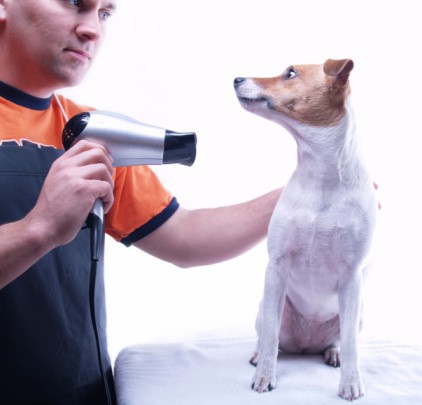Different injuries can occur with your dog while grooming her. Skin injuries can occur during clipping or shaving. Be careful when clipping or shaving dogs that have extremely matted coats because mats are usually very close to the skin. The closer your tools get to the skin, the more chances there will be for a cut or bruise. In the case of a small cut, rinse the area to remove loose hair, pat dry, and apply a small amount of styptic powder to stop the bleeding. It is important to keep the dog calm.
Wrap the wound with clean gauze and contact your vet for further treatment. In the case of nipping the dog’s tongue, apply pressure with a dry towel to control the bleeding. If the dog doesn’t cooperate, run a slow stream of cold water on the injury to help constrict the blood vessels and slow down the bleeding.
Leg Injuries
If your dog jumps from the grooming area and hurts his leg, it is important, if you suspect that he has broken a bone, to immobilize the leg as soon as possible to avoid further injury. Using the inner cardboard tube of a paper towel roll as a “cast” could help keep the leg immobilized until you get to the vet. Open the cardboard tube with scissors and after wrapping the injured leg with gauze, wrap the tube around the leg and secure it by wrapping it again to keep it in place.
If you can’t hold the dog while making a phone call, place it in a small area to restrict as much of the dog’s movement as possible.
First-Degree Burns
The skin will remain intact showing some redness and possible local inflammation.
Treat the area with a slow stream of cold water or hold a washcloth soaked in cold water on the area
for a few minutes to be sure the skin’s temperature drops. After the skin has cooled off, pat dry and apply some aloe very gel. Avoid applying oils such as butter or ointments because they will keep the area hot instead of cooling it down.
First-degree burns most likely can be treated at home without a vet visit, but if the symptoms don’t go away it is important to contact your veterinarian because it could be an indication that deeper skin tissues have been affected.
Second-Degree Burns
These burns are more serious. The skin will show extreme redness and depending on the amount of exposure to the heat, blisters will appear. Second-degree burns need to be treated by a veterinarian as soon as possible. Cool the area with a clean, preferably sterile, cloth that won’t leave lint on the wound.
Keep re-wetting the cloth to help reduce the temperature of the affected area and stop deeper tissue damage. Like with first-degree burns, do not apply any butter, oil, or ointment. Focus on keeping the area cold while you get the dog to the vet.
Knowledge is power. Knowing some basic first-aid procedures will help you react calmly and with confidence, keeping your dog calm as well. First aid is exactly that—first aid. Its objective is to relieve a dog from pain and discomfort, but it should be followed by a call to your veterinarian to assess if further treatment is necessary.
Never leave your dog unattended in the grooming area, whether it’s a grooming table or a counter top. Unattended dogs may jump off the grooming area and hurt themselves.
While blow-drying your dog, make sure they are calm and in a ventilated area to avoid overheating. Dog skin is very sensitive and can burn easily. It is important to keep the hair dryer on the lowest heat setting and at a safe distance (about 15 inches [38.1 cm]) so as not to burn the skin. While bathing, sudden changes in water temperature can easily burn your dog’s skin.
The most common grooming-related burns are those from hot water or hot air.


